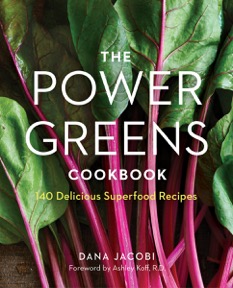Like many of us in the food business, Dana Jacobi has followed her passions and has been doing what she loves for decades.  She started her food career as an unpaid kitchen worker in France; Dana says that she’s “the first woman to apprentice in several French 3-star restaurants.”
She started her food career as an unpaid kitchen worker in France; Dana says that she’s “the first woman to apprentice in several French 3-star restaurants.”
I met Dana a bit further along in her career when she was working at Prodigy — one of the first online consumer services. That’s were her writing career began, with one of first food blogs. Beginning in the late 80s, she penned The Bytable Feast, an online only food column. Since then she’s written 15 cookbooks, including the most recent The Power Greens Cookbook. To give you the flavor of her newest book on sale April 12, we’ll be sharing a couple of her recipes inspired by seasonal flavors and ethnic flavors on Bite of the Best.
– bonnie
BonnieBOTB
Follow @BonnieBOTB
Which food product or gadget would you never give up? My silicone mini spatula. Scoop-shaped, it is perfect for scraping out jars, bowls and getting between the blades of my Vita-Mix. I am stunned at how long leafy greens keep when I store them in the Debbie Meyer green plastic boxes sold on TV, the kind with four locking tabs. They keep lettuce, arugula, cilantro, watercress, scallions and other greens beautiful for even a week or longer, parsley for up to a month. The tabbed kind is the only one that works. Using them has more than paid for what they cost.
What do you like to serve when you entertain? To enjoy my guests I start with substantial nibbles as a first course, perhaps hummus topped with dukkah, za’atar or sumac, guacamole accompanied by mini poppadoms, and caponata made with dark greens from my new The Power Greens Cookbook, served on semolina crostini, all set around the living room. They spark conversation and are familiar enough to enjoy comfortably. I serve two mostly made-ahead main dishes, one is always meatless. Chicken baked in tomatillo sauce and collard greens cacciatore are a good pair, served with hot, chili-spiked green rice and quinoa pilaf with carrots and kale stems. Dessert is fruit and something chocolate. It’s local berries with cream or sliced stone fruit macerated in orange juice and vanilla extract, plus brownie dippers, a biscotti from The Essential Best Foods Cookbook, in spring-summer deep-dish apple pie and sweet potato truffles in fall-winter. For friends who do not drink alcohol, I put out club soda and a few kinds of bitters for making a bitters spritzer. At brunch, I add a pitcher of parsley-ginger lemonade. When guests linger around the table, grappa and an amaro, the Italian digestive accompany coffee. In summer, dark rum on the rocks is my after-dinner favorite.
course, perhaps hummus topped with dukkah, za’atar or sumac, guacamole accompanied by mini poppadoms, and caponata made with dark greens from my new The Power Greens Cookbook, served on semolina crostini, all set around the living room. They spark conversation and are familiar enough to enjoy comfortably. I serve two mostly made-ahead main dishes, one is always meatless. Chicken baked in tomatillo sauce and collard greens cacciatore are a good pair, served with hot, chili-spiked green rice and quinoa pilaf with carrots and kale stems. Dessert is fruit and something chocolate. It’s local berries with cream or sliced stone fruit macerated in orange juice and vanilla extract, plus brownie dippers, a biscotti from The Essential Best Foods Cookbook, in spring-summer deep-dish apple pie and sweet potato truffles in fall-winter. For friends who do not drink alcohol, I put out club soda and a few kinds of bitters for making a bitters spritzer. At brunch, I add a pitcher of parsley-ginger lemonade. When guests linger around the table, grappa and an amaro, the Italian digestive accompany coffee. In summer, dark rum on the rocks is my after-dinner favorite.
Describe your “last meal?” Revisiting favorite places and foods I love. It would be spaghetti with sea urchin, made like it was at Sariddù in Mondello, Sicily, and baked fresh baccalà with potatoes, liberally bathed in olive oil, then duck or goose with an extra serving of crisp skin and a chunk of seared prime rib steak, all memories of good family gatherings, followed by the green salad of Boston and limestone lettuces, watercress, baby cucumber, fresh chervil and a lemon-shallot vinaigrette served at L’Archestrate in Paris. Dessert will be a peach with flesh barely firm enough to contain a flood of sun-warmed juice with the perfect balance of sweetness and acidity, recalling California discoveries, followed by pralinés à l’ancienne from Le Chocolat Alain Ducasse in Paris. For breakfast at dawn, I will have crusty baguette slathered with the very best butter and a really good cup of coffee.
What food is your secret guilty pleasure? Bacon.
What is your go-to neighborhood restaurant? New York City is my neighborhood. There are so many ethnic places and restaurants featuring farm-centric locavore that demand going beyond my Upper East Side Manhattan neighborhood. Craving a dish can decide where I eat, like the creamy beans at Porchetta, the mole negro at La Palapa, or the elementally simple dragon bowl at Angelika Kitchen, all in the East Village. In summer, the vegetable plate at Buttermilk Channel in Carroll Gardens, Brooklyn is like a trip to the country. And so is the sunny Ample Hills scoop shop in Prospect Heights, where Coconut Fudge Sorbet echoes the intense sorbet de cocoa amer at Berthillon, in Paris.
What is one food product most people don’t know about, but should? Cocktail bitters are trendy now  but still under appreciated. Have several kinds – aromatic, orange, coffee, vanilla or chocolate and smoked chili are a good range. A few drops lift the flavor of foods and add and something indefinable to dishes from butternut soup, brownies, or even chicken broth, to marinara sauce and balsamic vinaigrette. They are even more useful when using a minimum of salt. See for yourself in asparagus, radish and watercress salad with bitters vinaigrette in my new cookbook.
but still under appreciated. Have several kinds – aromatic, orange, coffee, vanilla or chocolate and smoked chili are a good range. A few drops lift the flavor of foods and add and something indefinable to dishes from butternut soup, brownies, or even chicken broth, to marinara sauce and balsamic vinaigrette. They are even more useful when using a minimum of salt. See for yourself in asparagus, radish and watercress salad with bitters vinaigrette in my new cookbook.
Describe your worst kitchen disaster and how (if possible) you saved it: Suvir Saran makes incredible tomato chutney. The first time I used his recipe, not paying attention, I bought the wrong kind of tomatoes. And used a very deep pot. I ended up with 2 quarts watery, delicious liquid with tomato chunks. It would be mush if I cooked it down enough to be chutney, so I simmered it just enough to serve as soup. It ended up as the vivid, spicy Indian tomato soup in my 12 Best Foods Cookbook.
Who was your most influentihal mentor? Oldways in the 1990s took food writers, chefs and scientists on encyclopedic Mediterranean trips, including Morocco, Spain, Turkey, Crete and many regions of Italy. The scientists taught about the health benefits of olive oil and the Mediterranean diet. From local cooks, respected pursuers of authentic cooking like Paula Wolfert and Nancy Harmon Jenkins as well as American chefs inspired by local cooking and ingredients, we learned about cuisines and cultures from the soil up. Visiting local artisans transformed how I blended flavors and understood people living outside the U.S. It changed how I cook and how I listen to world news.
To follow Dana Jacobi on Twitter, click here.







Thanks and inspired!